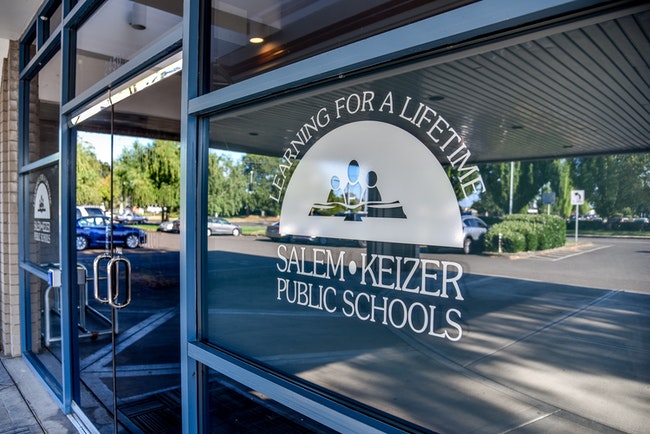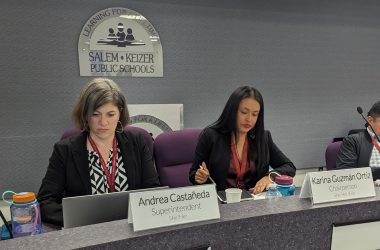
The Salem-Keizer School District will add more counselors and social workers to district schools and create a middle school alternative education program under a $1.5 billion budget proposal Superintendent Christy Perry presented Tuesday to the district’s budget committee.
The budget assumes local schools will resume full-time, in-person classes in the fall, though it maintains the district’s Enhanced Guided and Digital Education program, commonly called EDGE, for students and families who want full-time online school.
Among Perry’s goals is helping students who are struggling both academically and socially after more than a year of disrupted schooling caused by the pandemic.
“The school district is the primary social service provider in our community, providing essential food, clothing, technology and other essential resources,” Perry wrote in her budget message.
Her budget calls for adding a social worker to every district high school, as well as the middle schools serving the highest share of low-income students in the district. It also adds two high school counselor positions.
Some of those positions are funded through the corporate activity tax legislators passed in 2019 to give local schools more money for expanding academic and social support for students. Legislators cut that funding, the Student Investment Account, last year as Oregon faced significant revenue shortfalls due the pandemic. But it’s expected to rebound this fall, allowing the district to move forward with plans that had been on hold.
District schools would also add about 13 full-time speech language pathologists, bringing the district total to 59. That’s enough to give each elementary school its own pathologist rather than splitting them between two schools, assistant superintendent Kraig Sproles said. He said that will give pathologists more time to spend with students by decreasing travel time.
The middle school alternative education program Perry has proposed largely involves shuffling employees from existing positions, so its budgetary impact is small, but Perry highlighted it as one example of district efforts to better meet student needs. More details about that program will be released later this spring.
About $400 million of the total budget is for ongoing school construction projects funded by a property tax increase voters approved in 2018. That money can’t be spent on district operations.
District leaders face far more uncertainties in planning for the fall than in prior years. Among them: how many of the hundreds of local students who unenrolled from public school during the pandemic will return?
Mike Wolfe, the district’s chief operating officer, said they counted about 1,500 students across the district who either unenrolled from public school during the pandemic or didn’t register for kindergarten. That affects state funding, which is allocated largely on a per-student basis.
Next year’s budget assumes about half of those students will come back, which would put district enrollment at about 40,800 students, down from 41,570 two years ago.
But Perry said the true number will depend in part on state health guidelines that remain in effect for next school year, such as requiring students to wear masks. Some families may decide to enroll or unenroll once those guidelines are finalized, which will likely be over the summer.
The district’s contract with its teacher union also expires at the end of June, and bargaining hasn’t yet begun on a replacement contract, Perry said. That means any pay increases aren’t factored into the budget. To compensate, Perry said she allocated more money toward the district’s contingency fund.
District leaders face more unknowns heading into budget season than in prior years, including how much money legislators will appropriate for the state schools fund. Perry built the budget assuming a $9.4 billion fund, but Gov. Kate Brown’s budget proposal calls for only $9.1 billion.
That would be an increase from the $9 billion allocated for the previous two years, but Mike Wolfe, Salem-Keizer’s chief operating officer, said that increase isn’t enough to account for rising district costs, particularly the cost of labor and benefits.
“This is a really, really, bad biennial funding scenario for the state school fund. And I don’t think we can overemphasize that it’s really bad,” Wolfe said.
Any differences for the coming school year could be made up with federal grant money the district is receiving as part of multiple Covid relief packages passed by Congress over the past year. That money is budgeted at $140 million to be spent between now and September 2023.
Wolfe said relying on temporary federal grants to meet operating expenses is unsustainable in the long-term.
The district’s budget committee will meet again May 18 and May 24 to hear public comment on the budget. The committee could vote on May 24 to recommend the budget to the school board, or hold additional meetings that week.
The committee includes seven community volunteers as well as all seven elected school board members. Committee members are Jaqualine Bechtel, Barbara Ghio, Lisa Harnisch, Levi Herrera-Lopez, Oni Marchbanks, Adriana Miranda and Tyson Pruett as well as school board directors Satya Chandragiri, Danielle Bethell, Kathy Goss, Sheronne Blasi, Paul Kyllo, Marty Heyen and Jesse Lippold Peone.
Contact reporter Rachel Alexander: [email protected] or 503-575-1241.
BE PART OF OUR TEAM FOR SALEM’S BENEFIT: Accurate local information is vital for any community and that’s harder to come by in this day of “anyone can post anything” to social media. People in communities without trained journalists working for them don’t have accurate, trusted information. Help Salem avoid that fate – join in putting fuel in the tank of Salem Reporter to keep it growing, going strong. Here’s how:
SUBSCRIBE: A monthly digital subscription starts at $5 a month.
GIFT: Give someone you know a subscription.
ONE-TIME PAYMENT: Contribute any amount and you support giving the people of Salem local news otherwise missing. (You can also mail your contribution: Salem Reporter, 72585 Middle Fork Lane, Bates OR 97817)

Rachel Alexander is Salem Reporter’s managing editor. She joined Salem Reporter when it was founded in 2018 and covers city news, education, nonprofits and a little bit of everything else. She’s been a journalist in Oregon and Washington for a decade. Outside of work, she’s a skater and board member with Salem’s Cherry City Roller Derby and can often be found with her nose buried in a book.









